Wycombe and Swansea both enjoyed successful campaigns last season with Wycombe gaining promotion from League One and Swansea finishing in the last playoff spot. However, the two sides have had contrasting starts to this Championship season. Swansea have not conceded a goal so far and have picked up four points, with a 1-0 win at Preston and a goalless draw at home to Birmingham. Steve Cooper’s men will be hoping that they can go one better than this and gain promotion to the promised land of the Premier League. Wycombe, on the other hand, have lost their opening two games. They were unfortunate in their first game to lose out to a 90th minute header against Rotherham, while their second game saw them lose comfortably 5-0 away at Blackburn.
The transfer window is still open and so far, both teams have made some changes to their squads. Given Wycombe’s transfer budget they have not stretched their resources too far and have added the likes of Uche Ikpeazu and Daryl Horgan to bolster their attacking options. Swansea have been relatively busy also and have used Steve Cooper’s contacts to add some more valuable loan options. These include players such as Freddie Woodman, Marc Guehi, and Morgan Gibbs-White who will only add to the quality of the team. It is notable that Rhian Brewster has been recalled from his loan and is now back at Liverpool, which is a blow given his late season impact, and Swansea have decided to sign Wigan’s Jamal Lowe.
The two managers adopt differing styles of management. Swansea manager Steve Cooper advocates possession-based football and high pressing, while Gareth Ainsworth likes to set his team up in a low block and play a long ball style when they gain possession. So, in this tactical analysis we look at the potential tactics of both sides and how their approaches may differ from their opening two games. An analysis of key players and tactical patterns will help us predict how this Championship clash will pan out.
Predicted lineups
Wycombe will most likely setup in their traditional 4-2-3-1 formation. However, there will have to be alterations, especially given the suspension of Darius Charles after his red card against Blackburn. Ryan Allsop has been a mainstay in the Wycombe goal and will keep his place. In terms of the back four, Jacob Grimmer and Joe Jacobson will play in the full-back positions, with Anthony Stewart most likely playing alongside Ryan Tafazolli in a new centre-back pairing. The two defensive midfielders so far have been Matt Bloomfield and Alex Pattinson and we believe Ainsworth will stick with this. In front of them, the three have also been unchanged so far with Fred Onyedinma and David Wheeler flanking new signing Daryl Horgan. Up front on his own will be Scott Kashket who will be looking to break his scoring duck this season in this important clash for the Chairboys.
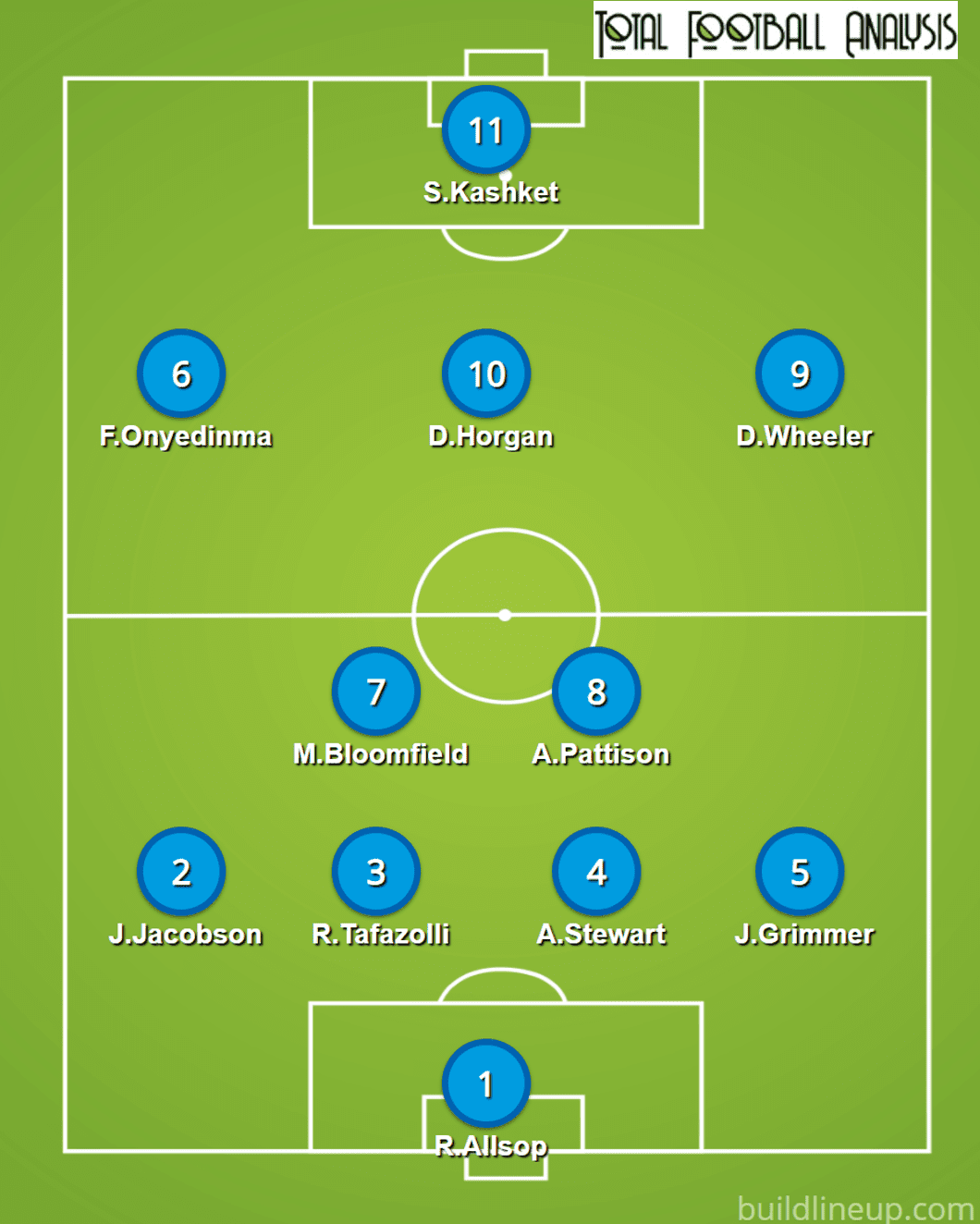
Swansea have also been extremely settled this season in terms of their starting lineups. In fact, Cooper has selected the same eleven for both of Swansea’s games so far this season. This has consisted of on loan goalkeeper Freddie Woodman behind a back three of Ben Cabango, Joe Rodon, and on loan Chelsea defender Marc Guehi. Swansea have opted for a four-man midfield in front of the back three with wing-backs Jake Bidwell and Connor Roberts playing outside central midfielders Matt Grimes and Korey Smith. On loan Wolves midfielder Morgan Gibbs-White has played in the number 10 role behind the striker pairing of Andre Ayew and Jamal Lowe. The formation is a 3-4-1-2 and is a formation that was successful for Cooper’s man at the back end of last term.
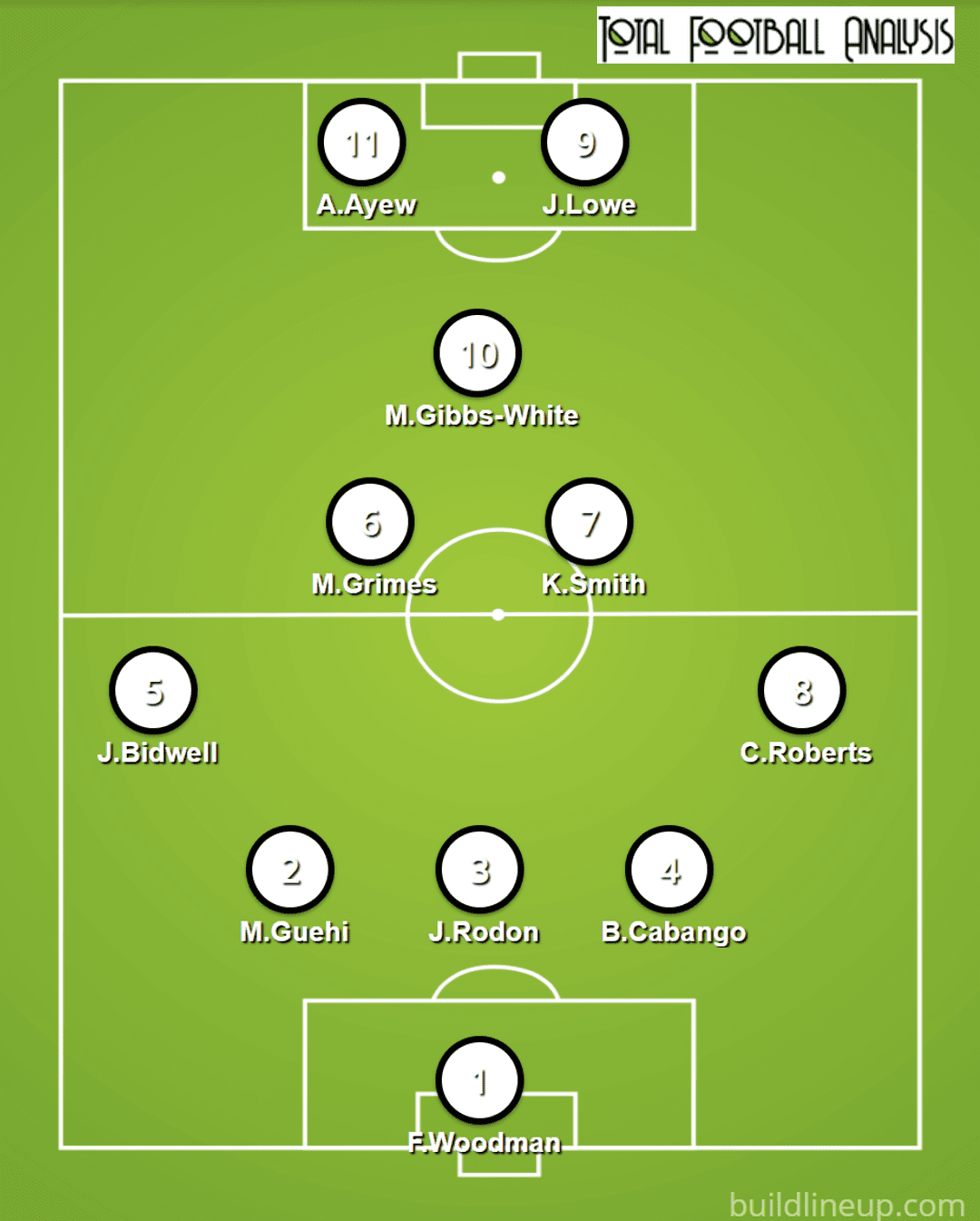
Kashket as the outlet
Adebayo Akinfenwa was the main striker and top scorer for Wycombe in their successful promotion campaign last year, however, he has not featured so far this season as a result of a knee injury. This has left a void up front with Scott Kashket being the benefiter and has started both of Wycombe’s opening two games. It is notable that Kashket is only 5ft 7inches and is hardly a physical striker, in comparison to the extremely strong Akinfenwa who is a big part of Wycombe’s long ball approach. As a result of Kashket’s height, Wycombe have slightly altered their attacking approach this season with an emphasis on hitting the ball into wide channels and into space. This is instead of long high balls that were usually played into Akinfenwa last season. Ainsworth’s tactical adjustment is something that hasn’t yet resulted in a goal but has shown signs of promise.
An example of Wycombe’s changed attacking approach, especially in transitions can be seen below. This attack is from their 1-0 opening day loss to Rotherham and it occurred only a minute into the game, and most definitely should have resulted in the opening goal for the Chairboys.
In this instance, Rotherham had just lost the ball from a header and right-back Wheeler was there to hit the ball long. However, the ball was not simply a hopeful long ball and was placed in the wide right channel and in behind the centre-back for the pacey Kashket to latch onto.
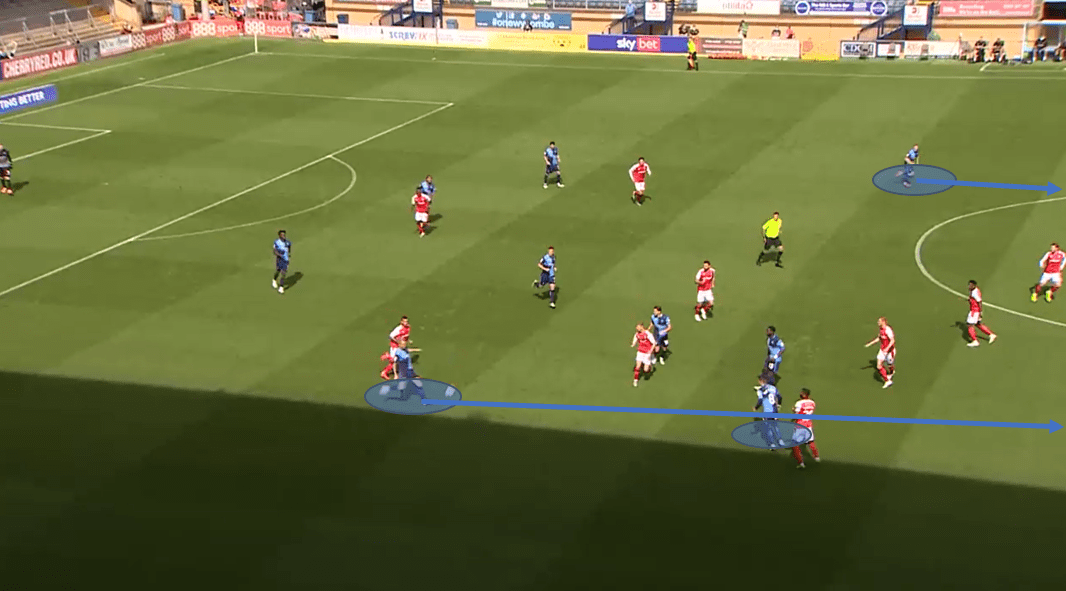
Although Kashket was able to beat the man and square it back to the incoming Horgan, he was unable to convert a golden opportunity, which can be seen in the frames below. This move showed that Wycombe could maintain a solid base of midfielders in central areas, while leaving Kashket up front on his own. Ultimately, this allowed Wycombe to get on the front foot from one long ball, which is something that would have surprised Rotherham, given that Wycombe predominately played with a hold up striker throughout last season. Ainsworth will know that his men must be more clinical in front of goal, especially against a team like Swansea. The chance shown in the frames below had an xG of 0.69, and in this game, they had an overall xG of 2.15, so chance creation for Wycombe doesn’t seem to be a huge problem just yet and will be something they look to continue on Saturday.

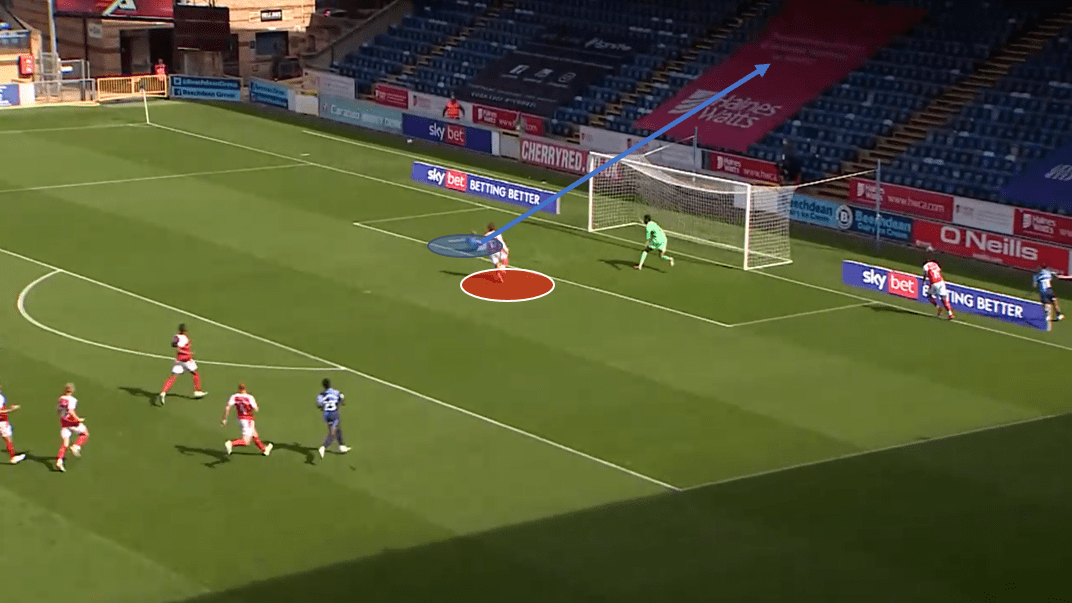
Wycombe heavily relied on this attacking outlet alongside set pieces in a game where they only had 45% possession. Yet, Ainsworth’s men gained further joy from this tactic throughout the game and it will be something they will be looking to target against Swansea. This is mainly because of Swansea’s three-at-the back-system and they will surely place an emphasis of exploiting the wide channels and dragging the wide central-defenders out from their original positions.
A further example of Wycombe utilising these channels from long balls can be seen in the frames below. After a failed through ball from a Rotherham midfielder, Charles found himself with the ball at his feet and Wycombe’s clear attacking strategy can be seen by his quick decision making. Charles’ first instinct was to look up and locate not only Kashket but also the wide channel where the space was for Wycombe to trigger a meaningful transition.
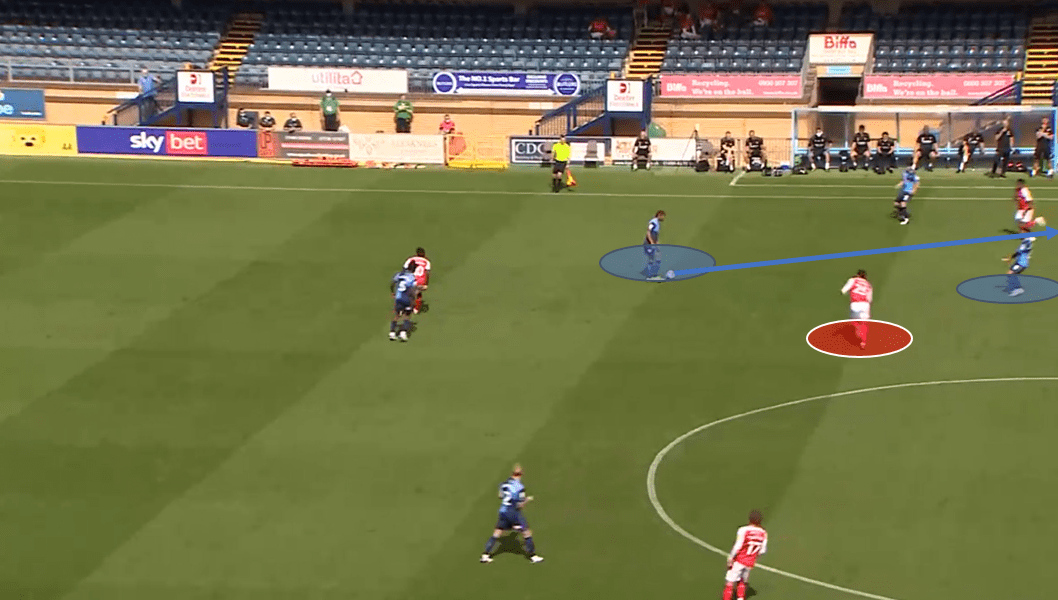
As you can see in the next frame below, Kashket was closely tracked by Rotherham defender Michael Ihiekwe, but the Wycombe attacker was able to win a throw in. It is notable that Ihiekwe is a lot taller than Kashket, which is why Wycombe are forced to play these long, wide balls when Kashket is the lone striker. This is particularly important for Saturday’s clash against Swansea, who have both tall right and left centre-backs in their back three system. Cabango and Guehi are 6ft 2 and 6ft 1 respectively, meaning an aerial battle would hardly be beneficial to Wycombe in their attempt to build sustainable attacks and break their goalscoring duck.
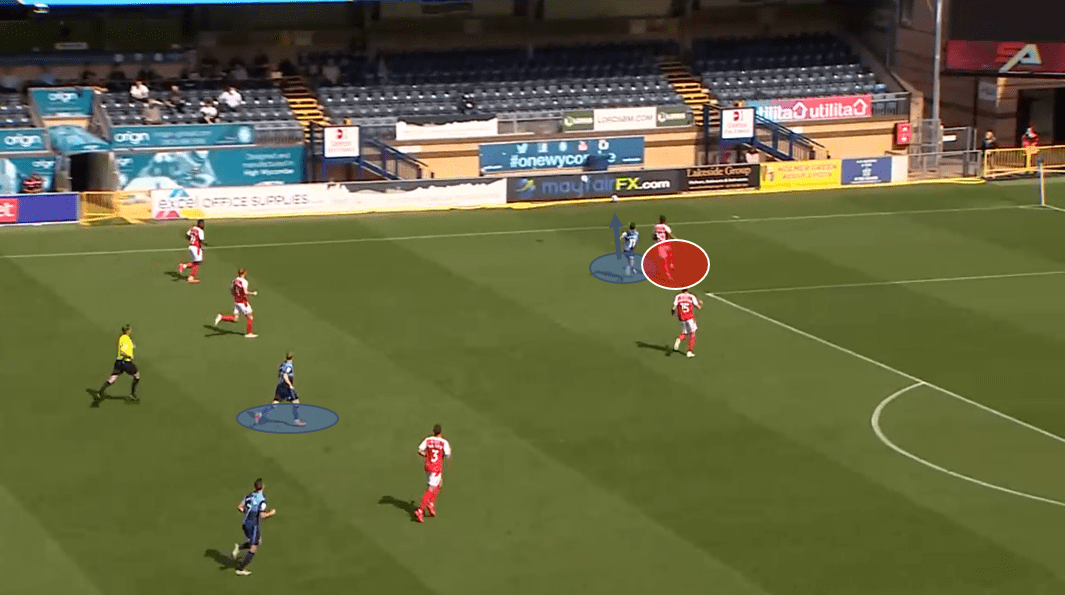
Leaving gaps defensively
Six goals conceded in two games hardly represents a solid defensive start and Wycombe’s defending has showed some worrying signs so far. Swansea’s young and vibrant attack will be looking to exploit these weaknesses. A theme of a couple of Wycombe’s conceded goals this season have been extremely similar and will be something that Cooper will have looked at it. The frames below illustrate this by showing the second goal for Blackburn in the 5-0 loss as the first example.
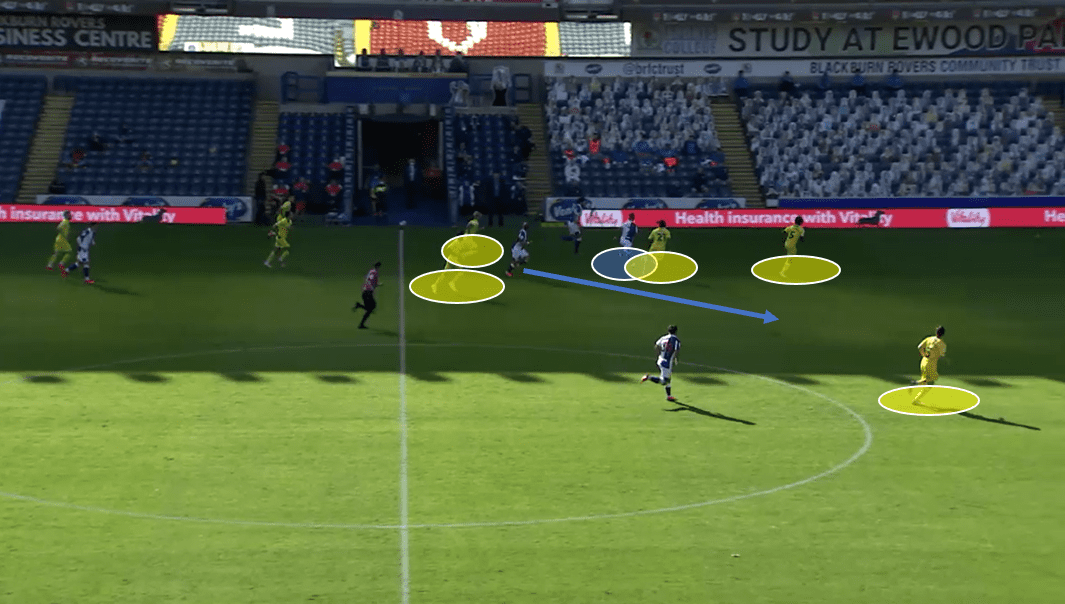
Adam Armstrong has picked up the ball on the left-hand side and left-sided centre-back Charles has rushed across the pitch to close the ball down. This meant that both centre-backs found themselves almost directly in line with each other, leaving a huge gap in their defensive shape and isolating left-back Jacobson. As a result of Jacobson’s isolation, he decides to go over to the area of danger, which leaves acres of space for Tyrhys Dolan to run into after incise passing from Ben Brereton and Lewis Holtby to release the young winger. It is alarming how much space Dolan found himself in and he was able to score on his second shot after having the original shot saved, which is shown in the two frames below.
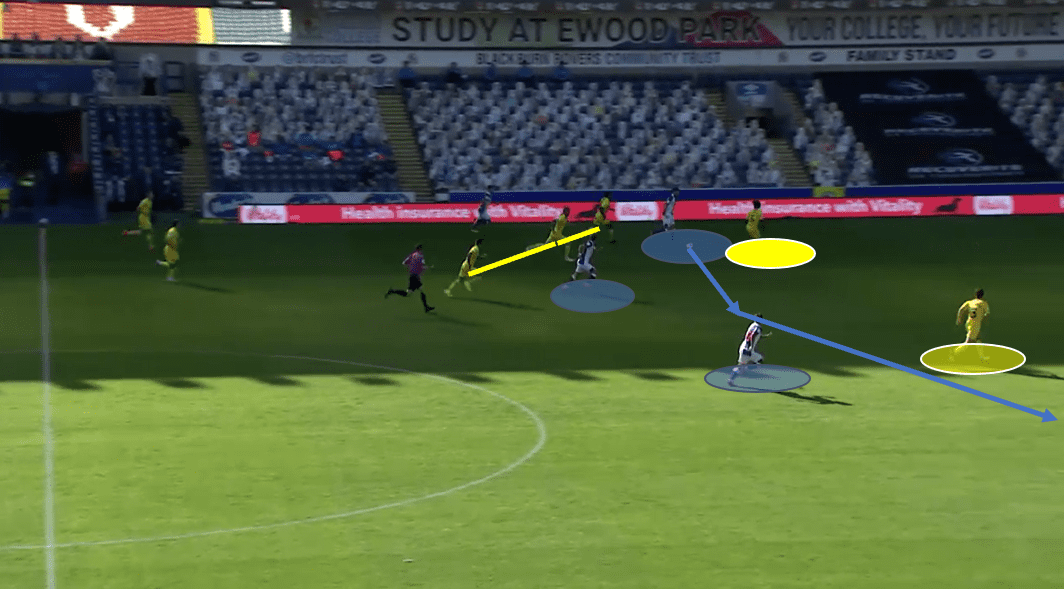
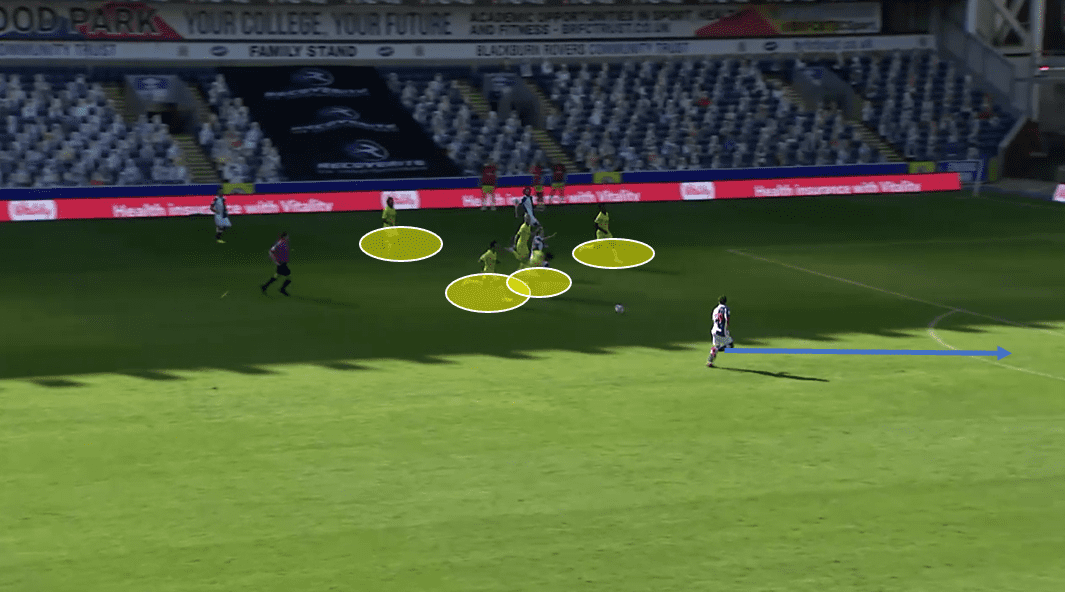
This complete loss of shape and defensive structure by each defender dragging themselves towards the danger was something that happened later in this game as well. In the next example, John Buckley has found himself surrounded by Wycombe players but is still allowed to play a through ball to Armstrong on the other side of the pitch.
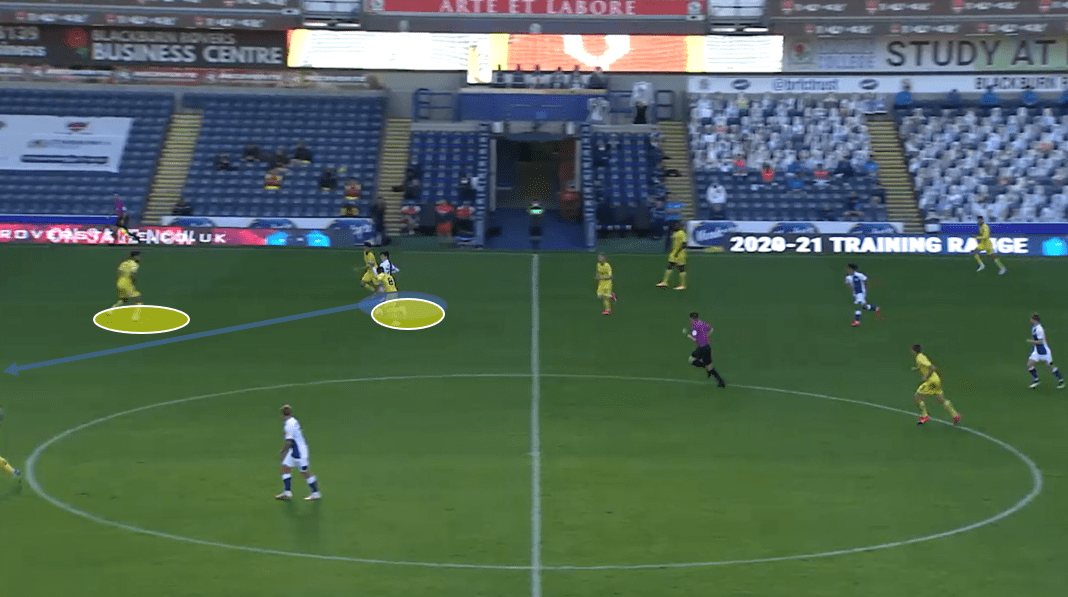
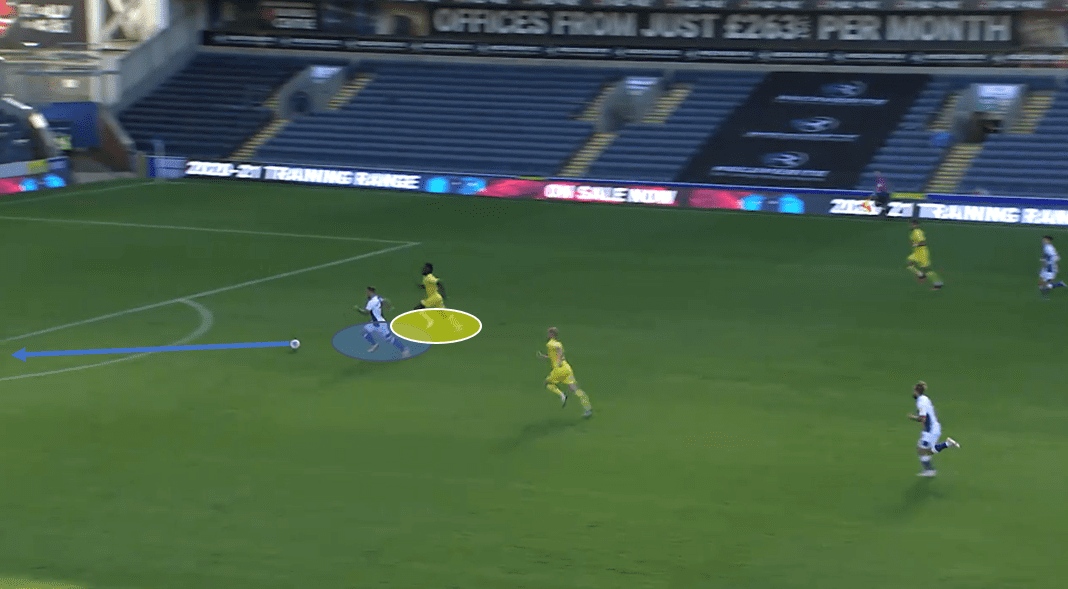
Armstrong is found in space against Stewart who is the one becoming isolated this time and this allows Armstrong to rampantly finish into the bottom corner. Yet again, Wycombe’s defenders rushed towards the ball in numbers without realising where the danger was. Attacking wide and attracting defensive numbers with the end goal to switch it instantly when the space appears, was a clear tactic from Blackburn that worked, and one that Swansea should try and replicate.
Five at the back when defending
As noted earlier, an important part of Swansea’s end of season form and greater defensive stability was the switch to a 3-4-1-2. This allowed them to attack with width and also maintain numbers centrally, while keeping a solid base of three centre-backs to sweep up the danger from transitions. Cooper has stuck with this tactic this season and it is the defensive improvements through this formation that have caught my eye. In Swansea’s 1-0 win at Preston, they only had 40% possession and remained defensively resolute at a ground that many teams struggle at. An example of their impressive defensive shape is shown in the frame below.
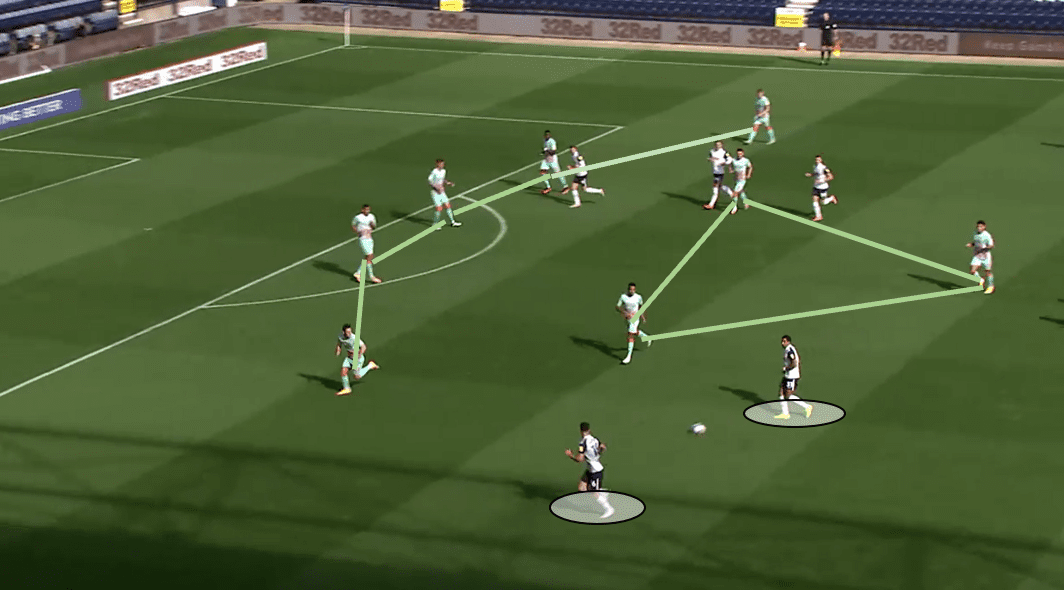
You can clearly see the positioning of the three centre-backs who are tucked narrowly together to maintain a solid base in central areas. The full-backs of Roberts and Bidwell are evidently higher than the centre-backs as their role is to be ready to close the winger at all costs. This is because they have the safety of three centre-backs inside them, but also a double pivot that protects the back line. An underrated aspect of Swansea’s defensive shape is the positioning of Gibbs-White, who is higher than the double pivot and is on the half turn. Gibbs-White is in this position to ensure that he is ready to occupy the vacant space between the central defensive midfielders but is also ready to spring forwards and be the link for Swansea to launch a counter attack. His role is vital defensively and in transitions shown by his winning goal, which is Swansea’s only goal of the season so far. It will be important to maintain a solid shape when defending against a Wycombe team that is aggressive and will look to challenge the back three with a more direct approach.
Importance of Swansea’s full-backs
The advantage of Swansea’s back three is that the full-backs can push on and help Swansea press more cohesively. The average position map from Swansea’s 1-0 win against Preston highlights the progressive nature of Cooper’s full-backs.
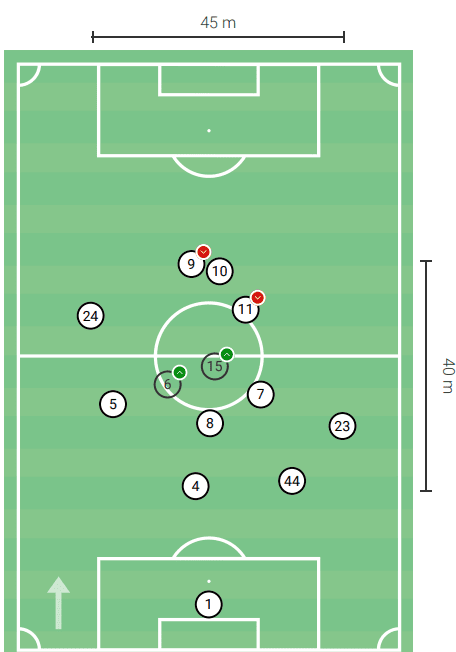
However, it is notable how deep Roberts is in comparison to Bidwell, with a clear tactic to attack the right side of Preston, highlighted by the high positioning of left centre-back Guehi. Swansea will be looking to press Wycombe constantly in Saturday’s clash with the aim to rush their long balls and isolate their lone striker. This will help Swansea dominate the game and maintain the pressure on a low-block Wycombe side. As a result of this, Ainsworth may look to introduce new signing Uche Ikpeazu to provide an aerial presence, which is something that the Chairboys have dearly missed so far.
The importance of the full-backs will be even more crucial in this game as Swansea will have vast amounts of possession. Therefore, the full-backs will help provide the much-needed width to support the numbers in central areas and to help them create opportunities from an alternative source. Examples of Bidwell and Roberts proving to be key in Swansea’s build-up play were evident in the Preston game, and help us predict their role in their attacking setup on Saturday. This can be seen in the frame below. Swansea’s opening goal was the perfect example of the high and wide full-back system that Cooper advocates in his system. Given that Bidwell is predominately the higher full-back given his power and crossing ability, it is unsurprising that he was able to supply the assist for the goal.
Bidwell was able to receive the ball after a huge switch from the other side of the pitch by Ayew in a crowded area. This allowed Bidwell to isolate their full-back, Alan Browne, with runners overloading the box awaiting the ball to come in. Not only was Bidwell’s first touch placed away from the full-back, but he was able to run it down the line and place the ball back into the danger zone where Gibbs-White put the ball in.
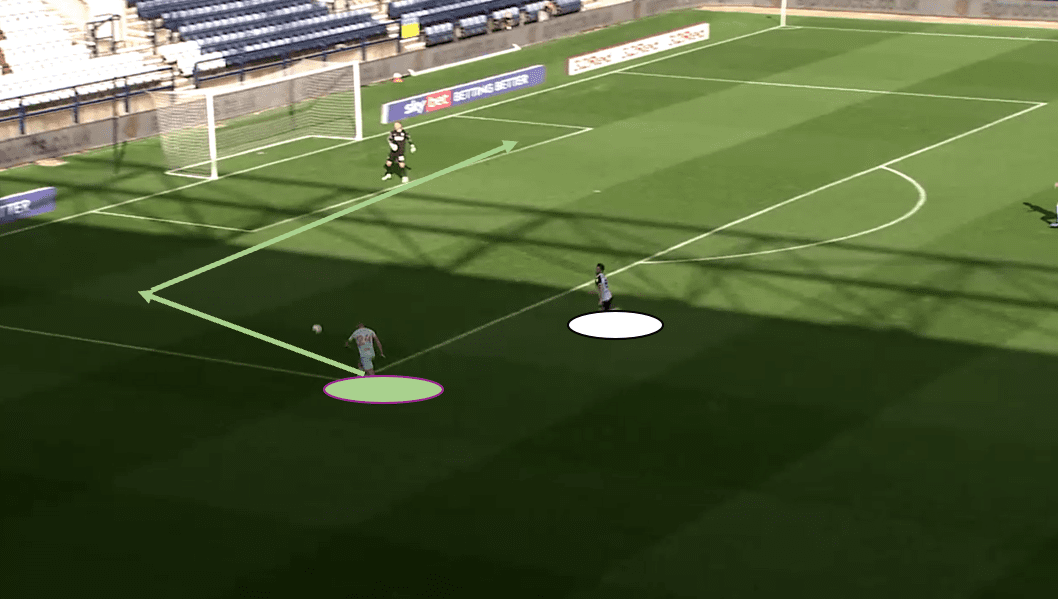
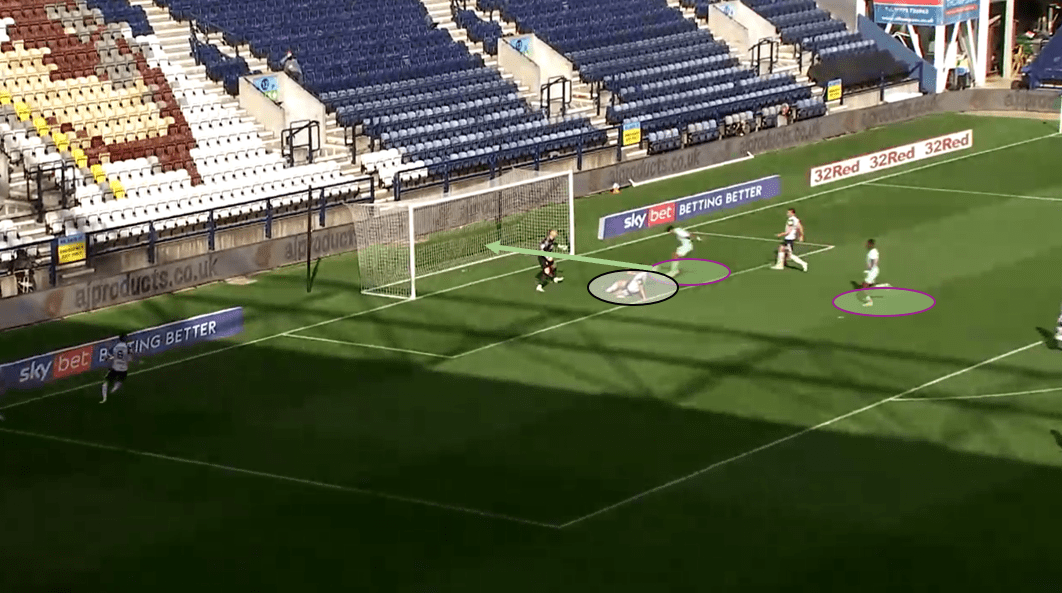
In fact, this type of build-up play is extremely like the way that Wycombe have conceded two of their goals this season. As we have already seen, Wycombe are prone to attracting large numbers to one side of the pitch, which leaves huge gaps on the other side, and this is exactly what has happened here. Therefore, I expect Swansea to target the left-hand side of Wycombe’s defence with the end goal to release Bidwell in a position of space and danger to hurt the Chairboys backline. The likes of Lowe and Gibbs-White will most likely be the players willing to attack the box in these types of situations. In order to combat this, Ainsworth should look to double up and press, by asking his right midfielder to support the full-back in an almost double full-back system. The aim of this will be to suffocate the dangerous Bidwell of space, but also to pin him back and get him running in the opposition direction, in an attempt to stem the flow of the match, which I believe will be one dominated by the Swans.
Swansea clearly place an emphasis on crosses and getting the ball out wide to the full-backs. This is something that is highlighted by the graphics below. Out of Swansea’s 59 crosses in the last five games, Bidwell and Roberts have provided 35 of these. Undoubtedly the impact of the full-backs in this match will play a big role in deciding the outcome of this match.
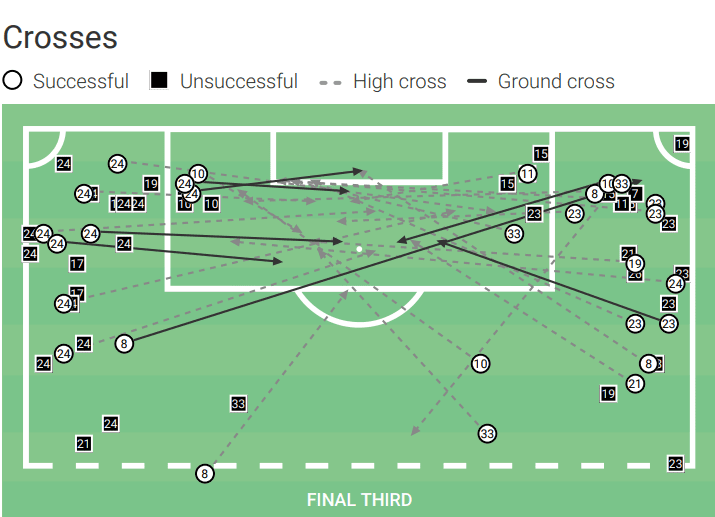
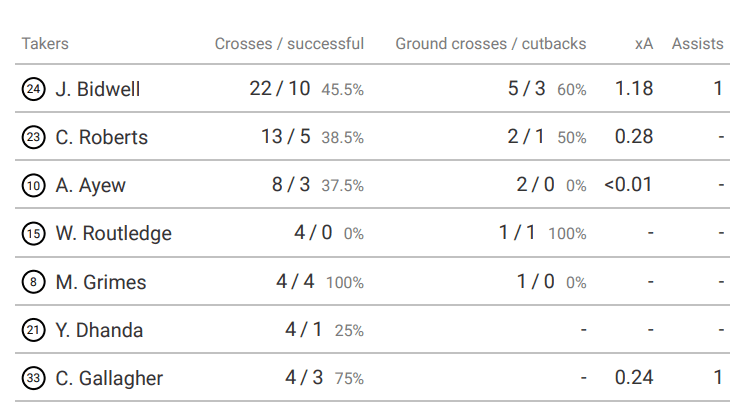
Conclusion and prediction
Wycombe 0-2 Swansea
Wycombe have, perhaps predictably, struggled so far this season and they already look set for a relegation battle. So far, they have missed their talisman Akinfenwa and defensively they have been unlike their usual selves in the opening two games. The introduction of Ikpeazu to the starting line-up is something that Ainsworth should consider, in order to provide a different option for the Chairboys going forward. On the other hand, Swansea have carried over their form, which led to them gate-crashing the play-offs last season and I believe that they will pick up their second win here. The introduction of Gibbs-White and Lowe while retaining the likes of Ayew, Bidwell, and Guehi mean they have a solid base. Swansea will dominate this game through possession and utilising the width through their attacking full-backs to hurt Wycombe and secure the three points.

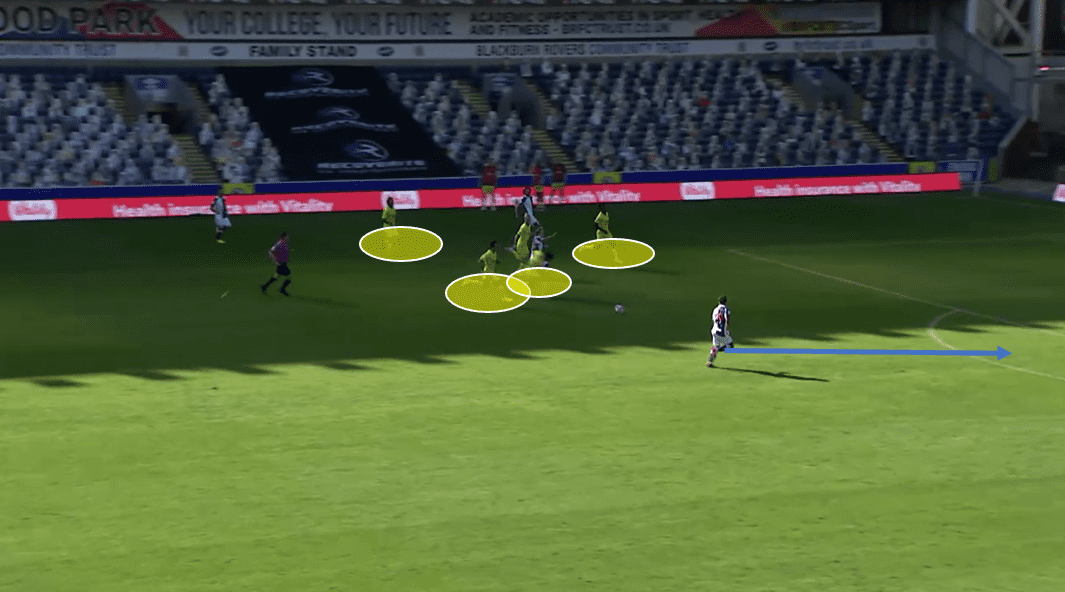



Comments